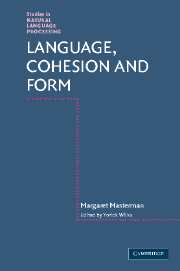Book contents
- Frontmatter
- Contents
- Preface
- Editor's introduction
- Part 1 Basic forms for language structure
- Part 2 The thesaurus as a tool for machine translation
- Part 3 Experiments in machine translation
- 6 ‘Agricola in curvo terram dimovit aratro’
- 7 Mechanical pidgin translation
- 8 Translation
- Part 4 Phrasings, breath groups and text processing
- Part 5 Metaphor, analogy and the philosophy of science
- Bibliography of the scientific works of Margaret Masterman
- Other References
- Index
7 - Mechanical pidgin translation
Published online by Cambridge University Press: 22 September 2009
- Frontmatter
- Contents
- Preface
- Editor's introduction
- Part 1 Basic forms for language structure
- Part 2 The thesaurus as a tool for machine translation
- Part 3 Experiments in machine translation
- 6 ‘Agricola in curvo terram dimovit aratro’
- 7 Mechanical pidgin translation
- 8 Translation
- Part 4 Phrasings, breath groups and text processing
- Part 5 Metaphor, analogy and the philosophy of science
- Bibliography of the scientific works of Margaret Masterman
- Other References
- Index
Summary
This chapter gives an estimate of the research value of word-for-word translation into a pidgin language, rather than into the full normal form of an output language.
Introduction
The basic problem in machine translation is that of multiple meaning, or polysemy. There are two lines of research that highlight this problem in that both set a low value on the information-carrying value of grammar and syntax, and a high one on the resolution of semantic ambiguity. These are:
matching the main content-bearing words and phrases with a semantic thesaurus that determines their meanings in context;
word-for-word matching translation into a pidgin language using a very large bilingual word-and-phrase dictionary.
This chapter examines the second.
The phrase ‘Mechanical Pidgin’ was first used by R. H. Richens to describe the output given at the beginning of Section 2 of this chapter (below), which, he said, was not English at all but a special language, with the vocabulary of English and a structure reminiscent of Chinese. Machine translation output always is a pidgin, whose characteristics per se are never investigated. Either the samples of this pidgin are post-edited into fuller English, or the nature of the output is explained away as low-level machine translation, or rough machine translation, or some vague remark is made to the effect that pidgin machine translation is all right for most purposes.
- Type
- Chapter
- Information
- Language, Cohesion and Form , pp. 161 - 186Publisher: Cambridge University PressPrint publication year: 2005

